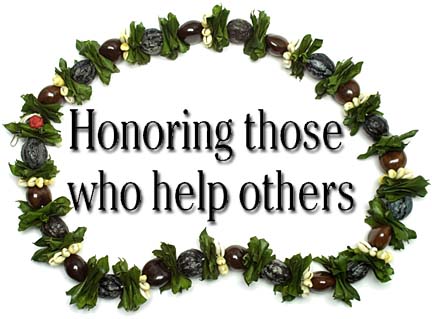

Windward's Community Works
group wins an HMSA award
for its efforts to rid its
neighborhood of drugs
In 2002, residents of Windward Oahu, vexed by a critical crystal methamphetamine problem in their community, took a stand against the turbulent "ice" scourge. Led by Community Works in 96744, a coalition of churches and social services groups, citizens rallied against the drug dealers and users that threatened to overrun their neighborhoods, with a demonstration designed to reclaim their communities.
"The dealers were blatantly selling it in front of everybody, right off the main street at parks and public places," said Pastor Keith Ryder of Light of Promise Ministries, a founding member of Community Works in 96744. "It was just getting too wild and too crazy."

Leading community activists of "Community Works in 96744," recipients of HMSA's Ola Pono Award are front, seated, Robert Naniole, left, and John Reppun. Standing from left, Bob Nakata, Rev. Keith Ryder and Andy Anderson. They are at the KEY Project in Kahaluu where a HCAP food distribution was taking place.
Soon afterward, a cousin of Ryder's with a history of drug-related problems ventured out behind his mountainside home and hung himself. It had been the third suicide in Ryder's family in as many years. "It was at that time that we decided to go after the problem with ice," Ryder said.
Their efforts earned Community Works in 96744 one of six HMSA Ola Pono Awards bestowed this year. The annual awards recognize individuals and groups who have made significant contributions in promoting safe, healthy, drug-free communities. A $1,000 award was donated to Kualoa-Heeia Ecumenical Youth Project.
HMSA is accepting nominations for the 8th Annual Ola Pono Awards through Dec. 1, with nomination forms available through Drug-Free Hawaii at 1-(800)-845-1946 or at www.hmsa. org. Nominees may be a volunteer, educator, youth, parent, business, civic club or church organization, any individual or group helping to prevent substance abuse and violence.
Other 2004 winners were: Leilani Perkins of Waipahu, Valerie Hoke of Kona, Rodney Iwasaki of Honolulu, the late surfer Rell Sunn, of Makaha, and the Kawaihau District Leadership Coalition.
RYDER AND fellow Community Works leader Rev. Bob Nakata started by organizing a town hall meeting, inviting government agencies, politicians and area citizens to attend.
"When the people came, they were ready to talk," says Nakata. "They went for three hours just pouring out their personal stories of dealing with ice. It was highly emotional,"
Ryder proposed a sign-holding demonstration from a local liquor stop to the stately banyan tree alongside the Hygienic Store in Kahaluu, two notorious drug-dealing spots along a milelong stretch of Kamehameha Highway.
"When the day came, we had several hundred people lining the highway," remembers Nakata. "Rather than end at the banyan tree, it went all the way down to Temple Valley Shopping Center and spilled over into Kaneohe."
Neighboring communities up north in Koolauloa, Laie and Kahuku organized simultaneous rallies and saw equally large turnouts. Inspired by the efforts of Community Works in 96744, other districts in Hawaii followed suit with demonstrations of their own.
"Within two or three months, there must have been eight or 10 communities around the state that did it," says Nakata. "I don't think any of us had seen anything like that happen so spontaneously."
The community mobilization caught the attention of filmmaker Edgy Lee, who filmed a portion of her documentary, "Ice: Hawaii's Crystal Meth Epidemic," in the area. The film, which aired simultaneously on 11 television stations statewide in September 2003, brought a greater awareness of the statewide ice plight and of the efforts of Community Works in 96744.
"We made a statement that we need everybody to pitch in and help fight this problem," says Ryder. "Everyone needs to step up and deal with problem as a community and a state."

Click for online
calendars and events.